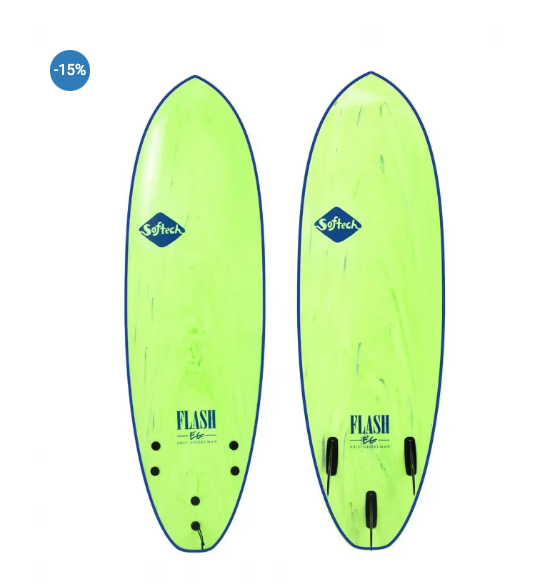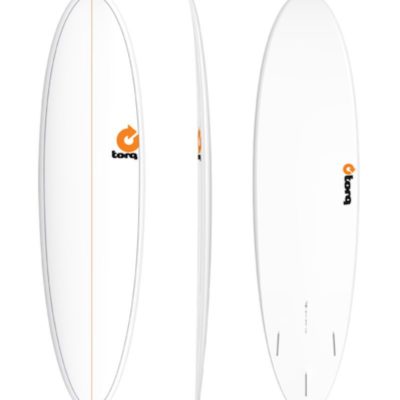Description
Softech Flash Eric Geiselman – FCS II – 3 Fin – Green Marble
The Eric Geiselman Flash will motivate you to surf on any given day due to the uncanny feel and performance similarities between a soft and hard skin board. This is performance with a serious injection of fun. This is a great all-rounder offering shortboard performance, and a perfect option for anyone wanting to hone their turning skills.
Size: 6’0″
Core: 100% Waterproof X-Density EPS Foam Core
Stringer: Single stringer
Fin Setup: Tri (x3 FCS II Fin Setup)
Fin System: FCS II
Volume: 5’0″: 32L | 5’7″: 36L | 6’0″: 39L
+ Leash Plug installed
+ FCS II Softflex Fins included
The FCS II Fin System
With the FCS II system, the need for any screws or tool to secure the fins has been eliminated. Simply insert the front of the fin into the plug and use downward pressure to lock the fin in place.
Easily insert & remove the fins based on the wave conditions or the rider’s ability. Don’t upgrade your board -just change your fins.
Brand
Softech surfboards
THE ULTIMATE IN SOFTBOARD FUN AND PERFORMANCE.
Handmade from highly durable materials, and constructed using proven manufacturing techniques, Softech surfboards are built to withstand the toughest of treatment and are available in a range of styles to suit the beginner through to the most experienced rider.
Inspired by the latest fiberglass surfboard designs, the Performance Series blurs the lines between serious ripping and having fun.
Loaded with features all wrapped up in a soft package, the Performance Series come with the FCS II Fin System so you can easily add, remove or upgrade your fins.
At Softech we want to make your initiation into surfing a fun, exciting and memorable experience.
Our Original Learner Series boards are designed to be buoyant and super stable so first timers can easily catch and ride waves, and build the skills to start performing basic turns.
THERE ARE MANY ASPECTS TO SURFBOARD SELECTION THESE ARE THE POINTS TO CONSIDER
LENGTH
Typically surfboards are measured in inches. The length is measured from the nose to the tail. Choosing the length of the surfboard is dependant on your size (weight, height), board type and waves conditions you wish to use the board for.
WIDTH
The widest point of the surfboard is measured from rail to rail. Generally the wider the surfboard the more stable the board, while a board with smaller width maintains better speed and performance.
BOARD THICKNESS
Surfboard thickness is measured from the top deck to the bottom. The thickness again has a bearing on the board’s performance. Professional surfers will tend to go for the thinner boards as they are lighter and offer better performance.The thicker boards are stronger and because there is more foam under the surfer the boards are more stable.
ROCKER
The bottom curve of a surfboard. Generally the more rocker the surfboard has the more loose (manoeuvrable) the surfboard will be. Where the flatter rocker surfboards will be faster, although they will lack the looseness. The nose is the tip of the surfboard, the nose can vary in shapes and size. Basically the thinner the nose the more response the board will perform, while wider noses are better for stabilization.
STRINGER
Used to increase the strength of a surfboard, a stringer (normally made from wood) runs down the length of a surfboards (typically in the centre of the board from the tip of the nose to the tail).
Boards built with Epoxy, Carbon Fibre and soft boards generally don’t have stringers.
FINS
Generally heavier surfers require larger fins to hold the waves better. Although if you prefer to ride a looser (less hold in the waves), smaller fins would be a better option.
FIN CONSIDERATIONS
Fin configurations have an effect on the ways your surfboards perform.
The following are some of the more common fin configurations.
SINGLE FIN
The single fin was the original fin configuration for surfboards. Based on the idea of the sailboat keel. Single fins are added stabilization and control on the powerful, larger waves, although lack manoeuvrability
TWIN FIN
Are great for small waves, being fast and manoeuvrable, but when put into tight spots on larger waves, they become hard to control. Popular with Fish surfboards.
THRUSTER 3 FIN
Widely recognized as the standard fin configuration, the thruster answers the shortcomings of the single fin and the twin fins configurations.
The thrusters give you stabilization, control and manoeuvrability in all types of surfing conditions.
This concept was the brainchild of Australia’s Simon Anderson
QUADS 4 FINS
With four fins in the water, Quads boasts an extraordinary amount of holding power in larger surf.
You may think that having four fins would sacrifice speed by creating more drag, but this is not the case.
The both sets of fins are working together on the rail, which makers believe they creates less drag than a board with a centre fin.
The manoeuvrability isn’t sacrificed either, with fins directly under your back foot, the quads are very responsive.
KEEL
Similar setup to the Twin Fin, although smaller (low profile) fins are generally placed wider (closer to the rails) on the surfboard.
Popular with Fish and Egg / Retro surfboards.
Heeft u hulp nodig bij uw aankoop? Neem dan gerust contact met ons op
+3170 201 5153
info@noordzeeboardstore.nl
Contact formulier



